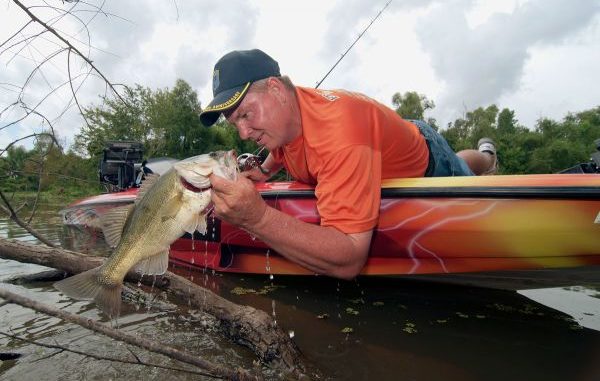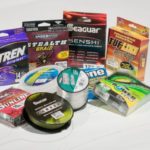
Each line type has its pluses, negatives
Today’s fishing is crowded with choices to be made. Where to fish and what to do when we get there are definitely on that list.
But even before hitting the water there are choices to be made, starting with what line to spool on your reels.
Monofilament once was the wonder line, but now there are so many choices it can be dizzying just to walk down the fishing aisle at Academy.
While there are now even hybrids lines, there are three main players: mono, fluorocarbon and braid.
Here are some thoughts from former touring bass pro and Reel in the Outdoors host Joe Thomas, who said the key to choosing the proper line is understanding the strengths and weaknesses of each option.
• Monofilament
Strengths
While some folks have moved away from mono, Thomas said there are still times when it’s the best choice.
“I still like mono for crankbaits, spinnerbaits and topwaters,” Thomas said. “Mono will always be the choice for topwaters because it floats.”
But he also likes that mono is more forgiving.
“You have some stretch,” he said. “I think a lot of guys who fish a lot, our reflexes are almost too fast. Mono provides some shock absorption.”
Thomas maximizes the amount of give when fishing reaction-provoking lures by combining the line with a fast-tipped rod.
Disadvantages
Mono is the least sensitive of the choices, so jigs, finesse baits and Carolina rigs don’t perform as well with this line.
“With anything you’ve got to feel (the strike), you have to have some sensitivity,” Thomas said. “Mono just doesn’t have that.”
The line also can cause hook-set problems on long casts because of its stretch.
And visibility of mono also can be a problem unless water conditions are stained.
“Even low-vis green is still visible to the fish in clear water,” Thomas said.
• Fluorocarbon
Strengths
Sensitivity and minimal underwater visibility combine to make fluorocarbon a great choice for many applications.
“Fluorocarbon is the real deal,” Thomas said. “Anything I’ve got to finesse or hop the bottom with, I’m going to use fluorocarbon.”
So this is his go-to for worms, jigs, tubes and Carolina rigs.
And fluorocarbon has much less stretch than mono, heightening its sensitivity.
“It has 30 percent less stretch (than mono), and that allows you to really feel the bait better,” Thomas said.
And the fact that the line sinks, means there is little slack when fishing bottom lures.
“Instead of curving from the rod tip to the lure, it goes straight to the bait,” Thomas said. “It gives you a more direct line for hook sets.”
Of course, that means the line works flawlessly with suspended jerkbaits or even crankbiats in certain situations.
“It allows the bait to achieve its maximum depth,” he said. “If you want to get a couple of extra feet out of a bait, use fluorocarbon.”
And then there’s the light-bending characteristics of fluorocarbon.
“It’s invisible under water,” he said. “That’s not a big issue when fishing with reaction lures like crankbaits: They’re either going to hit them or not.
“But when you’re using a finesse bait or bottom-hopping bait, the fish can really look at it before deciding whether or not to eat it.”
Lack of visibility also allows him to use heavier lines in clear water.
“Where I used to use 8-pound or even 6-pound mono, I can now use 10-pound fluorocarbon,” Thomas said. “You get the same number of bites, but you don’t have as much of a chance of breaking off.”
Disadvantage
Fluorocarbon can be difficult to see when pitching and flipping jigs and worms, although tinting can help mitigate the issue.
Lack of stretch also can cause problems because it’s not a solid line like braid.
“Sometimes fluorocarbon will shatter on the hook set,” Thomas said. “You’ve got to modify the hook set or loosen the drag.”
To reduce the odds of breaking off fish, Thomas ups his line diameter as much as possible. For example, 25-pound fluorocarbon is used when fishing jigs and Carolina rigs.
Line memory is another inherent problem with fluorocarbon.
“It can be a little more difficult to fish when you first start fishing with it,” Thomas said. “You need to change your line often. That will alleviate a lot of your memory problems.”
That brings in one of the main concerns: Fluorocarbon can cost as much as twice the going rate of monofilament.
• Braid
Strength
Line strength is the primary advantage of braided lines, which are simply solid fibers woven together to create so-called “super lines.”
Braid is perfect for working jigs and plastics in highly abrasive environments like mats of hyrilla, barnacle-encrusted docks or other abusive cover.
“The majority of the time when I’m fishing braid, I’m flipping or pitching,” Thomas said. “Braid is really abrasive resistant.”
However, he favors braided line whenever he needs to maximize his “feel” of his lures.
“The sensitivity is huge,” Thomas said. “Braid is the most-sensitive line on the market. It really telegraphs the strike.”
That makes it perfect for such lures as lipless crankbaits fished in vegetation.
“When the bait hits the grass, you can snap it free,” he said. “Or if it gets caught up, the line will cut the grass.”
Of course, lack of stretch is another real advantage to the angler.
“You can get a hook in a fish easier, even on a long cast,” Thomas said.
Uncoated braid has zero memory, making it much easier to cast than other types of line, but Thomas actually prefers a coated line like Spider Wire Stealth.
“It gives the line some memory, so you don’t get looping around the rod tip,” he said. “It also will cast better, and won’t be as damaging to the (rod’s) guides.”
Braid also is perfect for fishing topwaters because the lack of stretch makes it easier to hook fish: In fact, you can pretty much just life the rod tip and let the fish do all the hook-setting for you.
Disadvantages
Lack of stretch can be a problem when setting the hook, if reels aren’t properly adjusted.
“A lot of time you can actually set the hook too hard or tear the hook out when fighting a fish,” Thomas said. “The line doesn’t stretch, so you have to modify the hook set and use rods that absorb that shock.”
His choice is a medium-heavy fiberglass rod to provide some give.
Braid also is extremely visible to fish.
“It’s opaque, so in clear water you don’t get many bites,” Thomas said.
He also believes the line’s very braided make-up produces a line unsuited for fishing heavy wood cover.
“I think the fish can hear when it comes through bushes,” Thomas said. “That’s why I only use it when I’m fishing grass.”
Price also is an issue, with braid costing about twice as much as monofilament.




